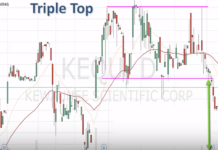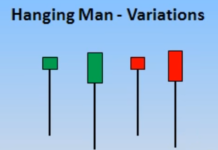1-2-3 pattern is a common formation made of 3 key elements. This pattern indicates that the trend has changed its direction. Also, a 1-2-3 pattern may occur at the boundary of a trading range or the end of a trend retracement. A 1-2-3 pattern is a time-tested tool that is successfully used by traders worldwide. One of the major Price Action patterns, it helps determine a possible direction of a price by accurately predicting changes in market sentiments at an early stage.
Before reading the article and writing your questions in the comments section, I recommend to watch this video. It’s not long but covers the biggest part of questions on the topic.
Table of Contents
Graphic analysis
As we’ve mentioned before, the pattern consists of 3 major elements. To examine each of them, let’s take a look at Fig 1.
Point 1 occurs when a price reaches a high and then bounces off in the opposite direction. As a result of a rebound, a price forms a new low (Point 2). Then a price retraces and forms a new high below the previous one. Then the price goes down, which is a confirmation of a trend reversal. Now a trader needs to wait for a Point 2 breakout to be able to go short.

For the most part, a 1-2-3 pattern forms at the end of a trend. Sometimes, you can see it occur during a trend retracement. If the pattern occurs within a trend, it’s an indication of a possible reversal or deep retracement. If the pattern forms within a trend retracement, it signals that the retracement is coming to an end (i.e. a trader can open a position in the direction of a trend).
Logics behind a 1-2-3 pattern
The pattern identifies the direction of the current trend. During a strong directed movement, each new low/high is lower/higher than the previous one. With the help of this pattern, a trader can find out whether the market is dominated by bulls or bears, or the price moves in a trading range. As soon as the familiar sequence is broken, it’s an indication of a trend reversal or retracement. This is when a 1-2-3 pattern emerges.

Why a 1-2-3 pattern works
The reason why a 1-2-3 pattern plays out is because a bunch of orders are activated in Point 2. If, before the pattern, there was a bullish trend, trend traders will use a trailing stop loss. On the other hand, traders are hoping for a retracement or reversal. These traders will also place their buy stops near Point 2 (near the low within the last retracement).
Why do traders choose Point 2 to set their buy stops? The answer has to do with the trend identification we’ve mentioned before. There is a bullish trend. Each new high is higher than the previous one. Each new low within a retracement is also higher than the previous one. Once Point 3 emerges, traders will see than the last top failed to form a new high, which is an indication of a possible reversal. Some trades will wait for a reversal for entry. However, most traders will wait for a Point 2 breakout to see how the price will behave. Once a breakout occurs, traders waiting for a reversal will go long. Long positions opened by traders hoping for a trend to continue, will get closed by stop-loss orders.

How to trade a 1-2-3 pattern
When it comes to a 1-2-3 pattern, you can use any timeframe. Feel free to use this setup on both high (e.g., D1) and low (e.g., M5) timeframes, depending on your preferred trading method. As for the choice of an underlying asset, there are no limitations either. However, there is one tip that applies to all price action patterns. Your selected currency (or another asset) must be trending and highly volatile. For the most part, traders use currency pairs with USD.
To trade a 1-2-3 pattern, you need to figure out your entry points and the sizes of stop loss and take profit. Whether you trade trend reversals or trend continuations, these three parameters are of crucial importance.
- Point 2 is your entry point. You place a buy stop/sell stop order slightly above the high/low within the last retracement. Why we choose this entry point was explained earlier.
- Stop-loss equals to the distance between Point 2 and Point 1. You need to place a stop-loss slightly above/below Point 1. Why? Because Point 1 acts as a strong support level in a down-trending market and a resistance level in an up-trending market. If this support/resistance level is broken, it’s highly likely that the previous trend will continue and you should close your current trade.
- Take profit also equals to the distance between Point 1 and Point 2. However, you need to lay off this distance from Point 3. Your take profit will be half the size of your stop loss. Alternatively, you can use different support/resistance levels as a take profit.
We used Fibonacci Expansion to set a take profit. We chose the 161.8 level as a take profit. The take profit was successfully achieved. The risk-reward ratio was at 1:1, which is higher than the ratio offered by the standard take profit placement method.

As you can see, you can ignore the standard take profit placement method with a not so good risk-reward ratio and opt for an alternative method, increasing your ROI.
More reliable signals within a trend retracement occur when a Point 2 breakout indicates the end of retracement and continuation of the main trend.
Furthermore, a 1-2-3 pattern can form at the end of a trend as an indication of an upcoming change. For bigger profits, be sure to only trade a 1-2-3 pattern that followed a strong trend. Plus, it’s important to filter out signals, only relying on the most accurate ones.
There is a continuous downtrend, with each new low and high lower than the previous lows and highs. Then the price breaks the downtrend line in Point 2 and forms a higher high. This is an indication of a possible trend reversal. Point 1 is the last low (a possible bottom of the trend).
Although we already have two points, we can’t be sure that what’s going on is a trend reversal and not a mere retracement. Entering the market at this point is too risky. We need to wait for a complete 1-2-3 pattern and Point 2 breakout.
Continuing to move beyond Point 2, the price forms a new low which is higher than the previous one. This means that the price is too weak to break the last low and form a lower low. This place is our Point 3. It completes the 1-2-3 pattern. It’s early for entry, though. There is still a possibility that we’re looking at price consolidation rather than a trend reversal. We need to wait for a Point 2 breakout.
The price continues to go up and breaks Point 2. If we placed a buy stop in Point 2, it would be activated and our trade would be closed by taking profit (if we used the standard take profit placement method, i.e. by laying off the distance between Point 1 and Point 2 from Point 3).
More info on 1-2-3 pattern
Here are some useful guidelines to help you correctly identify, interpret, and trade a 1-2-3 pattern:
- There must be at least 3 candles between Points 1 and 2 and Points 2 and 3.
- The bigger the distance between Points 1, 2 and 3, the more likely you’ll lock in a profit.
- If you’re trading intraday charts, you should look for a 1-2-3 pattern during European and American sessions, i.e. during high volatility.
- Like most Price Action patterns, a 1-2-3 pattern must have a confirmation pattern nearby. It might be a significant price level, a Fibonacci ratio or pivot level.
- Another important condition is that Point 1 has a long wick in the direction of a trend. (It’s as if the wick was pushing off of a support/resistance level.) If it’s a fully-fledged pin bar, great! If a pin bar is nowhere to be seen, your chances to reach your minimum take profit are lower.
- Even a perfectly formed pattern can’t guarantee that you’ll walk away with a nice profit. With that said, your risk per trade shouldn’t exceed 1-2% of your deposit.
- If the pattern formed its Point 3 and your take profit was not activated (or if your take profit was activated but the price continued to move sideways), you should close all non-activated orders.
Modifications
Many traders use a 1-2-3 pattern in combination with different indicators. Let’s examine how a 1-2-3 pattern and Stochastic Indicator work together.
Let’s find out how the oscillator behaves around Point 1. If a 1-2-3 pattern indicates an uptrend reversal, Stochastic must be in the overbought area. And vice versa. If a 1-2-3 pattern signals a downtrend reversal, Stochastic must be in the oversold area. This approach provides better signals and reduces potential losses. If, while Point 1 is emerging, Stochastic moves somewhere in the middle, this signal is not strong enough.

This is an H4 chart for AUD/USD with a 1-2-3 pattern. We use Stochastic as a confirmation tool. Point 1 has formed and Stochastic is in the overbought area, which is a good sign. To make sure we’re not dealing with a consolidation, we need to wait for a Point 2 breakout to enter the market.
It’s worth noting that your choice of entry methods, stop loss/ target profit placement methods, timeframe, and confirmation tools depends entirely on your trading strategy and other personal preferences. It’s important to remember that there’s no one-fits-all solution.






1,2,3 can be a little complex pullback and then priece continues in direction of original trend.. Isn’t that the case?
Am not an expert here, but from the little experience, 1 2 3 pattern can used at any time frame..but the bigger time frame more pips u get..suggest you to combine it with fibos
Can I scalp with the method sir?
This has worked very well especially with trading EUR/USD, I will make use of it in other currencies too
Good explanation…. Please keep mentoring us
This is one of the best continuation patterns cidering ons this adheres to the Elliot Wave Principle and the Fibonacci Retracement and Fibonacci Extension
This works with proper risk management. Thanks for sharing
That was very cool my man….Thanks!!!!!
Ideally to use a pitchfork there?